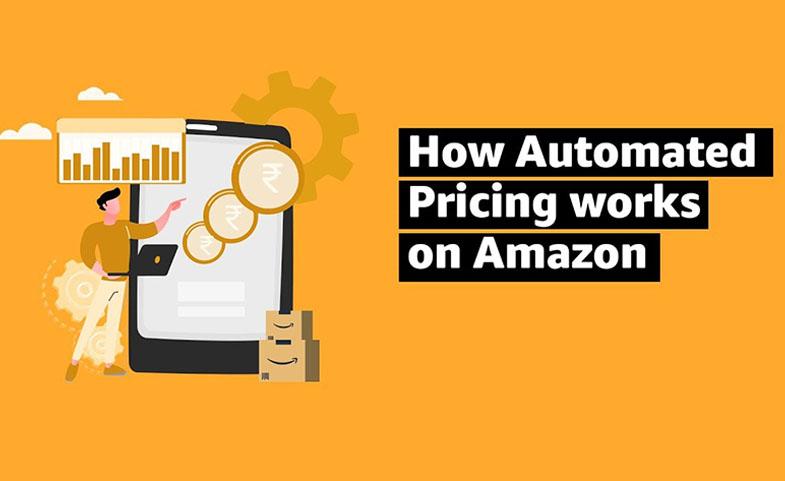In the fast-paced world of e-commerce, staying competitive and maximizing profits are top priorities for sellers on platforms like Amazon. One powerful tool that sellers can leverage is Amazon Automated Pricing. This dynamic pricing strategy allows sellers to automatically adjust their product prices based on various factors, optimizing competitiveness and profitability.
What is Amazon Automated Pricing:
Amazon Automated Pricing is a feature designed to help sellers stay competitive by adjusting their prices in real-time. The system takes into account factors such as competitor prices, Buy Box ownership, and other customizable parameters to automatically set and update your product prices.
Key Features of Amazon Automated Pricing:
Competitor-Based Pricing:
- Amazon's algorithm analyzes the prices of your competitors and adjusts your prices accordingly. This ensures that your products remain competitive in the marketplace.
Buy Box Strategy:
- The Buy Box is crucial for driving sales on Amazon. Automated Pricing allows you to set rules to increase your chances of winning the Buy Box, such as adjusting prices to be within a certain range.
Customizable Parameters:
- Sellers have the flexibility to set rules and parameters based on their unique business strategies. This includes adjusting prices based on inventory levels, sales velocity, and more.
Real-Time Updates:
- Pricing changes occur in real-time, allowing sellers to quickly adapt to market fluctuations. This responsiveness is key to maintaining competitiveness.
How does Amazon’s automated pricing work?
Amazon's automated pricing system is a game-changer for sellers, offering a dynamic way to adjust product prices in response to market shifts.
Competitive Buy Box:
- This rule centers around the coveted Buy Box. Sellers can set their prices lower, equal, or higher than the Buy Box price by a specified amount. This ensures competitiveness among sellers vying for that prime spot.
Competitive Lowest Price:
- Similar to the Buy Box rule, this one considers the lowest price for a product on Amazon. Sellers can choose to price below, at, or above the lowest price, aligning with market dynamics and maintaining competitiveness.
Competitive External Price:
- This rule extends the competition beyond Amazon by factoring in prices from other online marketplaces. Sellers can match or cap their prices based on competitors outside of Amazon, broadening the scope of competitiveness.
Based on Sales Units:
- This rule is a strategic move tied to sales volume. Sellers can adjust prices based on the number of units sold. Lower prices may kick in for sales below a certain threshold, encouraging increased customer purchases and boosting overall sales.
How much does Amazon’s automated pricing cost?
The beauty of Amazon's automated pricing tool lies in its accessibility—it's part of the professional selling plan and comes at no additional cost. For sellers, this means no extra fees to worry about. Whether you're a newcomer or a smaller seller, this free tool provides a level playing field, enabling effective competition with larger counterparts without incurring additional expenses.
How to set up automated pricing?
To set up automated pricing on Amazon, sellers can follow these steps:
- Sign in to their Amazon Seller Central account.
- Go to the “Pricing” tab and select “Automated Pricing” from the dropdown menu.
- Select the “Create a customized Pricing rule” option.
- Choose the rule type that you want to use for pricing adjustments, such as “Competitive Featured Offer” or “Sales Velocity.”
- Set a name for the rule you want to create.
- Select the marketplaces you want to create the rule. Click “Save and continue to select rule parameters.”
- Select the pricing attribute you want to set in the marketplaces that you have selected. Then click “Save this rule in Amazon.com.”
- Next, Click “Proceed to SKU selection” to choose the products.
- Set the pricing parameters for the rule, including the minimum and maximum prices, the desired profit margin, and any other relevant criteria.
- Choose the “Take action” option and select which action you want to choose.
- Review and confirm the settings for the automated pricing.
- Click “Start Repricing” to activate the automated pricing rule.
Before setting up automated pricing, sellers should research their competition, understand their costs, and set clear pricing goals and strategies to optimize their profitability and remain competitive in the market.
What are the Pros and Cons of Amazon's Automated Pricing
Pros:
Time and Energy Savings:
- Automated Pricing eliminates manual adjustments, letting sellers focus on business growth.
User-Friendly Interface:
- The tool's intuitive design simplifies pricing strategy complexities, aiding quick adaptation.
Elimination of Human Errors:
- Precision is guaranteed as the tool reduces the risk of human errors in price adjustments.
Effective Pricing Strategies:
- Constantly tracks competitor prices, ensuring sellers stay competitive without manual effort.
Cons:
Limitation on Selling at Higher Prices:
- Focus on competitiveness may hinder opportunities for premium pricing and higher revenue.
Tedious SKU Selection:
- Creating rules requires individual SKU selection, potentially time-consuming for diverse inventories.
Lack of Multi-Fulfillment Options:
- Sellers must choose between FBM and FBA, limiting flexibility in reaching a broader audience.
Inconsistent Competitor Beating:
- No guarantee of consistently beating competitors; outcomes may favor sellers with higher price thresholds.
How can you stop automatic pricing on Amazon?
To stop automated pricing on Amazon, sellers can follow these steps:
- Sign in to their Amazon Seller Central account.
- Go to the “Pricing” tab and select “Automate Pricing” from the dropdown menu.
- Choose which rule you want to stop automated pricing.
- Click the “Edit” button next to the automated pricing rule.
- In the pricing rule settings, scroll down to the bottom of the page and click on the “Delete” button.
- Confirm that you want to delete the pricing rule.
Once the pricing rule is deleted, automated pricing for that product will stop. The seller can then manually adjust the price or set up a new pricing rule if desired.
How do you qualify for Amazon’s automated pricing?
To jump on the automated pricing bandwagon on Amazon, sellers just need to follow these straightforward criteria:
List Your Products:
- First things first, sellers need to have active product listings (SKUs) on Amazon's marketplace. This ensures there are items ready for automated pricing adjustments.
Set Minimum Prices:
- Sellers should determine the minimum price for each SKU they want to include in the automated pricing system. This minimum serves as a safeguard, ensuring a baseline profit margin for their products.
Choose Your Pricing Rules:
- Time to pick the rule that suits your strategy! Amazon provides various pricing rules like competitive pricing and sales velocity. Sellers need to decide which rule to apply to each SKU, tailoring their automated pricing approach.
Account Type:
- While a Professional selling account can be beneficial for larger operations, it's not a strict requirement. Both individual and professional account holders can qualify for automated pricing. The key is having an active selling account on Amazon.
Best Practices for Amazon Automated Pricing:
Regularly Review and Adjust Rules:
- Markets are dynamic, and so should your pricing strategy be. Regularly review and adjust your pricing rules to align with changing market conditions.
Monitor Competitor Activity:
- Keep a close eye on your competitors' pricing strategies. Understanding their moves can help you fine-tune your own automated pricing rules for maximum effectiveness.
Balance Profitability and Competitiveness:
- Striking the right balance between profitability and competitiveness is crucial. Avoid pricing too high, risking loss of sales, or too low, compromising profits.
Test and Optimize:
- Experiment with different pricing strategies and rule configurations to identify what works best for your products. Continuously optimize based on performance data.
Conclusion:
Amazon Automated Pricing is a powerful tool that empowers sellers to stay competitive and maximize profits on one of the world's largest e-commerce platforms. By understanding its features, setting up effective rules, and following best practices, sellers can master the art of automated pricing and thrive in the dynamic world of online retail. Start leveraging Amazon Automated Pricing today to take your e-commerce business to new heights.


